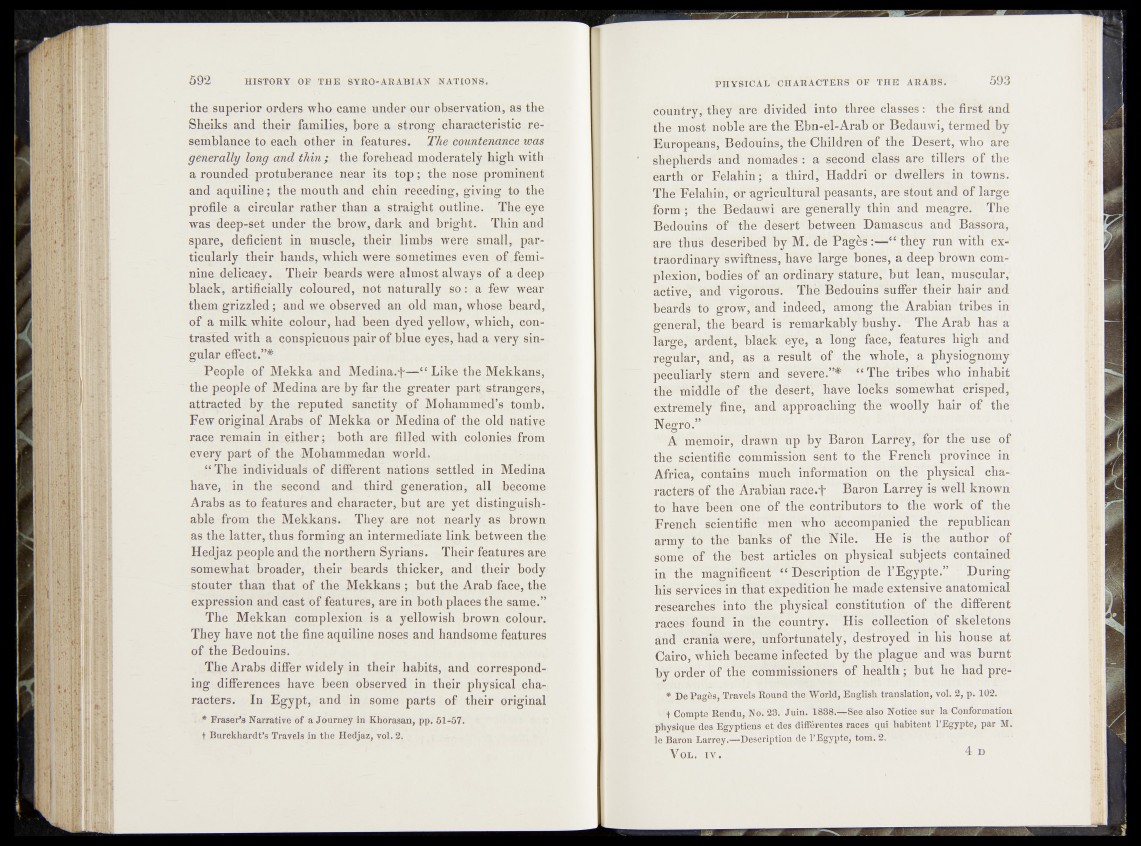
the superior qrders who came under pur observation, as the
Sheiks and their families, bore a strong characteristic resemblance
to each other in features. The countenance was
generally long and thin; the forehead moderately high with
a rounded protuberance near its top; the nose prominent
and aquiline ; the mouth and chin receding, giving to the
profile a circular rather than a straight outline;^ The eye
was deep-set under the brow, dark and bright. Thin and
spare, deficient in muscle, their limbs were small, particularly
their hands, which were sometimes even of .femi-
nine delicaey. Their beards were almost always of a deep
black, artificially, coloured, not naturally so: a few wear
them.grizzled; and we observed an old man, whose beard,
of a milk white colour, had been dyed yellow, which, contrasted
with a conspicuous pair of blue eyes, had a very singular
effect.”*
People of Mekka and Medina,*f—“ Like the Jkfekkans,
the people of Medina are by far the greater part: strangers,
attracted by the reputed sanctity of Mohammedi’s tomb.
Few original. Arabs of Mekka or Medina of the old native
race remain in either; both are filled with colonies from
every part of the Mohammedan world.
“ The individuals of different nations settled in Medina
have, in the second and third generation, all become
Arabs as to features and character, but are yet distinguishable
from the Mekkans. They.are not nearly as brown
as the latter, thus forming an intermediate link between the
Hefijaz people and the northern Syrians. Their features are
somewhat broader, their beards thicker, and their body
stouter than that of the Mekkans ; but th,e Arab face, the
expression and cast.of features, are in both places the same.”
The Mekkan complexion is a yellowish brown colour.
They have not the fine aquiline noses and handsome features
of the Bedouins.
The Arabs differ widely in their habits, and corresponding
differences have been observed in their physical characters.
In Egypt, and in some parts of their original
* Fraser’s Narrative of a Journey in Khorasan, pp. 61-57.
t Burckhardt’s Travels in the Hedjaz, vol. 2.
country; they are. divided into three classes : the first and
the most noble are the Ebn-el-Arab or Bedauwi, termed by
Europeans, Bedouins, the Children of the Desert, who are
shepherds and nomade^ : a second class are tillers of the
earth or F'élahin; a third, Iladdri or dwellers in towns.
The Felahin,. or agricultural peasants, are stout and of large
form ; the Bedauwi aré generally thin and meagre. The
Bedouins of the dMèrt'between Damascus and Bâssora,
are thus descfilied'''b)yM. de Pagès:—“ they run with extraordinary
swiftness*, have large bonêls,' â deép brown com-'
plexion; bodies of'an ordinary staturef put lean, muscular,
activJ^~ànd VigorOhS. The Bédouins'’suffer their hair and
beards to gfrow, and 'inlftëlf among nffie Arabian tribes in
general, !tfiè beard» fs remarkably bushy. The Arab has a
Ikrge, ardent, black ''ëfê',' a lin g face, features high and
ÀfgU’lar, and, as a result of The whole, a physiognomy'
peculiarly stern and ?Üevërë.”# “ The Tribes who inhabit
the middle^of tSe'desert; Tîave locks somewhat eriJped,
extremely fine, and approaching ' the ' woolly hair o f the
Négrb.”
' À membir, drawn up by Baron Larrey, for tbe'ush Of
thé scientific' commission Im f W the French province in1
Africa, contains much 'Mormation on the physical characters
of the Arabian race.f Baron Larrey is well known
tb' have been one of the contributors't^lne ‘ work of the
French scientific men -whofi accompanied( thé republican:
afihy to the banks of the Nile. He iÇ’the author of
some of the best artîclès on physical subjects contained1
in the magnificent“ Description de l*Êgyp%£j‘ During
his services in that expeditiöffheiÉade extensive anatomical
researches into the physical' constitution o f the different
races found in the èóunfry. His'"collection of Skeletons
and crania were, unfortunately, destroyed'in his house at
Cairo, which became infected by the/pl&hr.and was burnt
by order of the commissioners of health ; but he had pre-
* De Pagès, Travels Bound the,World, English translation, vol-. 2, p. 102.
Compte Rendu, No<>2S; Juin.5 lSag'.^-See also Notîôe sur la Conformation,
physique des Egyptiens et des diflfôrépte^ races qtiî habitent l’Egypte, par M.
le Baron Larrey.—Description <$e l’Egypte, fom. 2. •
V o l . i v . É S 4 d